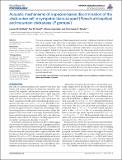Files in this item
Acoustic mechanisms of a species-based discrimination of the chick-a-dee call in sympatric black-capped (Poecile atricapillus) and mountain chickadees (P. gambeli)
Item metadata
| dc.contributor.author | Guillette, Lauren | |
| dc.contributor.author | Farrell, Tara | |
| dc.contributor.author | Hoeschele, Marisa | |
| dc.contributor.author | Sturdy, Christopher | |
| dc.date.accessioned | 2013-05-29T12:01:02Z | |
| dc.date.available | 2013-05-29T12:01:02Z | |
| dc.date.issued | 2010 | |
| dc.identifier | 49565296 | |
| dc.identifier | c78cef60-82c1-43bc-b7e5-677cb09e01ed | |
| dc.identifier | 79959606095 | |
| dc.identifier.citation | Guillette , L , Farrell , T , Hoeschele , M & Sturdy , C 2010 , ' Acoustic mechanisms of a species-based discrimination of the chick-a-dee call in sympatric black-capped (Poecile atricapillus ) and mountain chickadees ( P. gambeli ) ' , Frontiers in Psychology , vol. 1 , 229 . https://doi.org/10.3389/fpsyg.2010.00229 | en |
| dc.identifier.issn | 1664-1078 | |
| dc.identifier.uri | https://hdl.handle.net/10023/3566 | |
| dc.description.abstract | Previous perceptual research with black-capped and mountain chickadees has demonstrated that these species treat each other’s namesake chick-a-dee calls as belonging to separate, open-ended categories. Further, the terminal dee portion of the call has been implicated as the most prominent species marker. However, statistical classification using acoustic summary features suggests that all note-types contained within the chick-a-dee call should be sufficient for species classification. The current study seeks to better understand the note-type based mechanisms underlying species-based classification of the chick-a-dee call by black-capped and mountain chickadees. In two, complementary, operant discrimination experiments, both species were trained to discriminate the species of the signaler using either entire chick-a-dee calls, or individual note-types from chick-a-dee calls. In agreement with previous perceptual work we find that the D note had significant stimulus control over species-based discrimination. However, in line with statistical classifications, we find that all note-types carry species information. We discuss reasons why the most easily discriminated note-types are likely candidates to carry species-based cues. | |
| dc.format.extent | 2415122 | |
| dc.language.iso | eng | |
| dc.relation.ispartof | Frontiers in Psychology | en |
| dc.rights | © 2010 Guillette, Farrell, Hoeschele and Sturdy. This is an open-access article subject to an exclusive license agreement between the authors and the Frontiers Research Foundation, which permits unrestricted use, distribution, and reproduction in any medium, provided the original authors and source are credited. | en |
| dc.subject | Black-capped chickadee | en |
| dc.subject | Chick-a-dee call | en |
| dc.subject | Mountain chickadee | en |
| dc.subject | Operant conditioning | en |
| dc.subject | Songbird vocalization | en |
| dc.subject | Species discrimination | en |
| dc.subject | Sympatric | en |
| dc.subject | QL Zoology | en |
| dc.subject.lcc | QL | en |
| dc.title | Acoustic mechanisms of a species-based discrimination of the chick-a-dee call in sympatric black-capped (Poecile atricapillus) and mountain chickadees (P. gambeli) | en |
| dc.type | Journal article | en |
| dc.contributor.institution | University of St Andrews.School of Biology | en |
| dc.contributor.institution | University of St Andrews.Centre for Social Learning & Cognitive Evolution | en |
| dc.identifier.doi | 10.3389/fpsyg.2010.00229 | |
| dc.description.status | Peer reviewed | en |
| dc.identifier.url | http://www.frontiersin.org/comparative_psychology/10.3389/fpsyg.2010.00229/abstract | en |
This item appears in the following Collection(s)
Items in the St Andrews Research Repository are protected by copyright, with all rights reserved, unless otherwise indicated.

